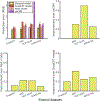A brain-based general measure of attention
- PMID: 35241793
- PMCID: PMC9232838
- DOI: 10.1038/s41562-022-01301-1
A brain-based general measure of attention
Abstract
Attention is central to many aspects of cognition, but there is no singular neural measure of a person's overall attentional functioning across tasks. Here, using original data from 92 participants performing three different attention-demanding tasks during functional magnetic resonance imaging, we constructed a suite of whole-brain models that can predict a profile of multiple attentional components (sustained attention, divided attention and tracking, and working memory capacity) for novel individuals. Multiple brain regions across the salience, subcortical and frontoparietal networks drove accurate predictions, supporting a common (general) attention factor across tasks, distinguished from task-specific ones. Furthermore, connectome-to-connectome transformation modelling generated an individual's task-related connectomes from rest functional magnetic resonance imaging, substantially improving predictive power. Finally, combining the connectome transformation and general attention factor, we built a standardized measure that shows superior generalization across four independent datasets (total N = 495) of various attentional measures, suggesting broad utility for research and clinical applications.
© 2022. The Author(s), under exclusive licence to Springer Nature Limited.
Conflict of interest statement
Competing interests
Authors declare no competing interests.
Figures

















References
-
- Chun MM, Golomb JD & Turk-Browne NB A Taxonomy of External and Internal Attention. Annu. Rev. Psychol 62, 73–101 (2011). - PubMed
-
- Weissman DH, Roberts KC, Visscher KM & Woldorff MG The neural bases of momentary lapses in attention. Nat. Neurosci 9, 971–8 (2006). - PubMed
-
- Heinrichs RW & Zakzanis KK Neurocognitive deficit in schizophrenia: A quantitative review of the evidence. Neuropsychology 12, 426–445 (1998). - PubMed
-
- Biederman J, Newcorn J & Sprich S Comorbidity of attention deficit hyperactivity disorder with conduct, depressive, anxiety, and other disorders. Am. J. Psychiatry 148, 564–577 (1991). - PubMed
-
- Levin HS et al. Neurobehavioral outcome following minor head injury: A three-center study. J. Neurosurg 66, 234–243 (1987). - PubMed
Publication types
MeSH terms
Grants and funding
LinkOut - more resources
Full Text Sources

